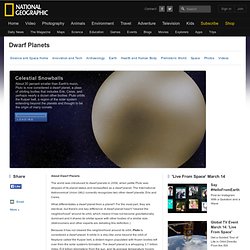

BBC Solar System – Uranus orbits the Sun tilted on its side. Sounds of our Solar System (1/2) Formation Stages. Scope.swf (Objet application/x-shockwave-flash) Pluto. Pluto, plus moons: Charon, Nix & Hydra.

A recent discovery (July 2011) shows that Pluto has four moons: Charon, Nix, P4, and Hydra. A recent discovery has resulted in Eris being found to be smaller than Pluto[1]. Here is What Wikipedia has to say about Pluto: “Pluto, formal designation is 134340 Pluto. Pluto’s size has been under debate since the discovery of Eris. Pluto is now the largest dwarf planet in the Kuiper Belt (a part of our Solar System) followed by Eris [1]. The largest dwarf planet in our solar system is Ceres which also happens to be the largest asteroid, and protoplanet. “I give my rebuttal, Pluto is a planet:” Pluto is not happy with being sent to the dog house! IAU sends Pluto to the dog house: On August 24, 2006, the International Astronomical Union (IAU) defined what it means to be a “planet” within the Solar System. definition excluded Pluto as a planet and added it as a member of the new category “dwarf planet” along with Eris and Ceres.
References. Is This Proof of Life on Mars? Want to stay on top of all the space news?

Follow @universetoday on Twitter View of Mars from Viking 2 lander, September 1976. (NASA/JPL-Caltech) The Curiosity rover is currently on its way to Mars, scheduled to make a dramatic landing within Gale Crater in mid-August and begin its hunt for the geologic signatures of a watery, life-friendly past. Solid evidence that large volumes of water existed on Mars at some point would be a major step forward in the search for life on the Red Planet.
But… has it already been found? Researchers from universities in Los Angeles, California, Tempe, Arizona and Siena, Italy have published a paper in the International Journal of Aeronautical and Space Sciences (IJASS) citing the results of their work with data obtained by NASA’s Viking mission. The twin Viking 1 and 2 landers launched in August and September of 1975 and successfully landed on Mars in July and September of the following year. The results, although promising, were inconclusive. Pluto moon discovery hints at future surprises for NASA probe. Skip to next paragraph Subscribe Today to the Monitor Click Here for your FREE 30 DAYS ofThe Christian Science MonitorWeekly Digital Edition The tiny new moon — announced July 20 and called P4 for now — brings the number of known Pluto satellites to four.

And the find, made with the Hubble Space Telescope, suggests that NASA's New Horizons probe could make some big discoveries, too, when it makes a close flyby of Pluto in 2015, researchers said. "The discovery of P4 just reinforces what we knew before: This is going to be completely new territory," said Hal Weaver, New Horizons project scientist at the Johns Hopkins University Applied Physics Laboratory in Laurel, Md. A long journey. Smallest Planet Yields Big Surprises. More Evidence of Mars’ Watery Past. Want to stay on top of all the space news?

Follow @universetoday on Twitter The transition between Acidalia Planitia and Tempe Terra from the Mars Express High-Resolution Stereo Camera (HRSC). Credit ESA/DLR/FU Berlin (G. Neukum) ESA’s Mars Express orbiter has sent back images revealing terrain that seems to have been sculpted by flowing water, lending further support to the hypothesis that Mars had liquid water on its surface at some point. The region seen above in a HRSC image is along the border of the Acidalia Planitia region, a vast, dark swath of Mars’ northern hemisphere so large that it’s visible from Earth. In 1877 the Italian astronomer Giovanni Schiaparelli named the region after a mythical fountain, where the three Graces of Greek mythology were said to have bathed.
In the HRSC image some of the etched valleys extend outwards from craters, implying that they were created by water emptying out from within the craters. Asteroids and Comets. Dark streaks on Mars bolster case for liquid water - space - 04 August 2011. By David Shiga Mars’s dust bowl image may need a makeover.

Dark streaks seen forming in summer and fading in winter might be signs of water flowing just beneath the surface. The sudden appearance of streaks on sloping ground have been attributed to present-day liquid water before, although their origin is still debated. Light streaks have been seen appearing on steep slopes in images taken years apart by NASA’s Mars Global Surveyor spacecraft.
And seasonal dark streaks have emerged in the north polar region. Liquid water flowing downhill might explain both types of events, but dust or sand avalanches could also be to blame. Now, new images have revealed a previously unknown population of seasonal dark streaks in Mars’s southern hemisphere, with characteristics that seem to tie them to liquid water.
Salty antifreeze They have been seen mainly on slopes in the southern hemisphere at mid-latitudes, though some have been seen near the equator, as well. Shifting grains Toehold for life? Dwarf Planets, Pluto Information. About Dwarf Planets The world was introduced to dwarf planets in 2006, when petite Pluto was stripped of its planet status and reclassified as a dwarf planet.

The International Astronomical Union (IAU) currently recognizes two other dwarf planets, Eris and Ceres. What differentiates a dwarf planet from a planet? For the most part, they are identical, but there's one key difference: A dwarf planet hasn't "cleared the neighborhood" around its orbit, which means it has not become gravitationally dominant and it shares its orbital space with other bodies of a similar size. (Astronomers and other experts are debating this definition.) Because it has not cleared the neighborhood around its orbit, Pluto is considered a dwarf planet. Pluto's surface is composed of a mixture of frozen nitrogen, methane, and carbon monoxide ices. Pluto has three known moons, Hydra, Nix, and Charon. The Neptune's sounds.